Who Controls the User Experience? AMD’s Carrizo Thoroughly Tested
by Ian Cutress on February 4, 2016 8:00 AM ESTBenchmark Results: CPU Short Form
Here are our results from our CPU tests. A reminder of our systems:
| System Overview | |||||
| µArch | APU | Base / Turbo MHz | Memory | Channel | |
| HP Elitebook 745 G2 | Kaveri | A10 PRO-7350B (19W) | 2100 / 3300 | 8 GB | Dual |
| HP Elitebook 745 G3 | Carrizo | PRO A12-8800B (15W) | 2100 / 3400 | 4 GB | Single |
| Toshiba Satellite E45DW-C4210 |
Carrizo | FX-8800P (15W) | 2100 / 3400 | 8 GB | Single |
| HP Pavilion 17z-g100 |
Carrizo | A10-8700P (15W) | 1800 / 3200 | 8 GB | Single |
| Lenovo Y700 | Carrizo | FX-8800P (35W) | 2100 / 3400 | 16 GB | Single |
Three Dimensional Particle Movement (3DPM)
3DPM is a self-penned benchmark, derived from my academic research years looking at particle movement parallelism. The coding for this tool was rough, but emulates the real world in being non-CompSci trained code for a scientific endeavor. The code is unoptimized, but the test uses OpenMP to move particles around a field using one of six 3D movement algorithms in turn, each of which is found in the academic literature. This test is performed in single thread and multithreaded workloads, and uses purely floating point numbers. The code was written in Visual Studio 2008 in Release mode with all optimizations (including fast math and –Ox) enabled. We take the average of six runs in each instance.
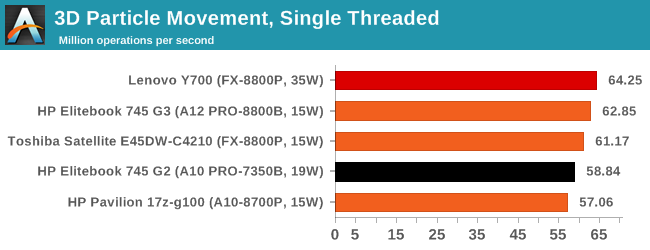
In the single threaded mode, the 35W part is able to boost to a higher frequency, giving it the lead. The interesting element here is the mix of 15W and 19W results, putting the Pavilion with the A10-8700P at the bottom. This comes through in the frequency charts, where the Kaveri was able to boost above 3000 MHz often:
For multithreaded:

The processors line up more as expected, with the 8800P still taking the top spot with Carrizo’s architecture resources showing the ability to scale better.
WinRAR 5.01
WinRAR is a compression tool to reduce file size at the expense of CPU cycles. We use the version that has been a stable part of our benchmark database through 2015, and run the default settings on a 1.52GB directory containing over 2800 files representing a small website with around thirty half-minute videos. We take the average of several runs in this instance.
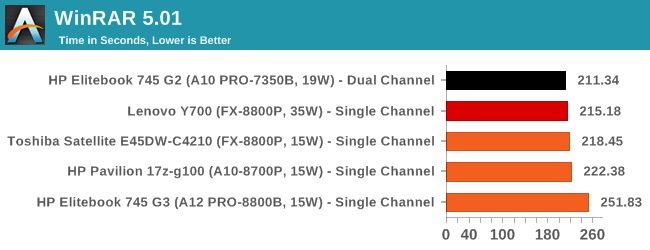
WinRAR is a benchmark which loves DRAM speed, hence why the dual channel Kaveri system wins despite the increased horse power and thermal benefits of the Lenovo Y700. Unfortunately, the single channel design methodology permeates through the OEMs because of the factor of price and upgradability – if a machine is sold with only one module, it can be upgraded later. The other element is that the Y700 design also caters for Carrizo-L as pin compatible, so despite having two modules in there the system will always be limited to single channel. This is, perhaps, a grave error with any situation that is memory limited.
POV-Ray 3.7 beta
POV-Ray is a common ray-tracing tool used to generate realistic looking scenes. We've used POV-Ray in its various guises over the years as a good benchmark for performance, as well as a tool on the march to ray-tracing limited immersive environments. We use the built-in multithreaded benchmark.
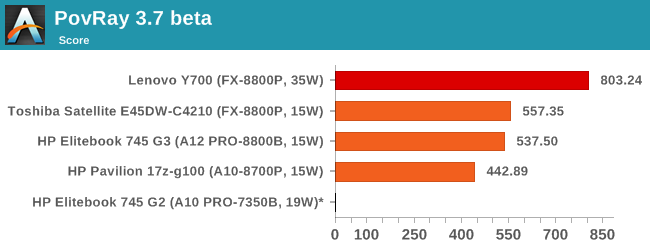
For whatever reason, our script failed to record the score when it came to the Kaveri system and we only realized after the systems were returned. Nonetheless, the capabilities of the other systems shine through, showing that the A10-8700P can seem to have a big frequency discrepancy against the FX-8800P models. In actual fact this can be attributed to the temperature limitations on the Pavilion:
The full threaded nature of POV-Ray means that we’re on the limits of the A10 APU already, but when the system hits 55C or so, it clocks back to 2100 MHz to save a few extra degrees.
If we compare that to the Toshiba:
The Toshiba system also hits a temperature limit, but the barrier is way up at 70C, causing the system to knock back to 64C. The CPU frequency difference between the two does not look that different despite the +25% score in favor of the Toshiba, making it slightly deceptive.
HandBrake
HandBrake is a freeware video conversion tool. We use the tool in to process two different videos - first a 'low quality' two hour video at 640x388 resolution to x264, then a 'high quality' ten minute video at 4320x3840. The low quality video scales at lower performance hardware, whereas the buffers required for high-quality can stretch even the biggest processors. At current, this is a CPU only test.
Unfortunately HandBrake also had issues on a couple of systems – the Lenovo and the Toshiba. All the HP systems gave results, where the HP Pavilion came out on top:


If we compare CPU use, the HP Pavilion is much better at using all of its threads than the Elitebook 745 G3:
7-Zip
7-Zip is a freeware compression/decompression tool that is widely deployed across the world. We run the included benchmark tool using a 50MB library and take the average of a set of fixed-time results.
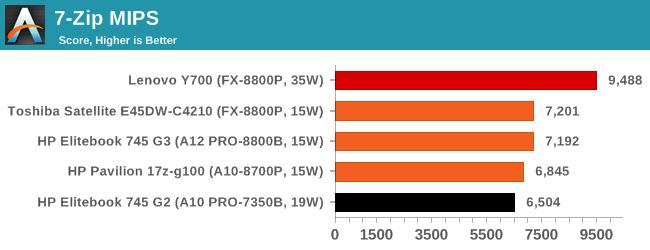
Despite being a purely in-memory benchmark, the G2 shows some inefficiency compared to the Carrizo systems. The slight discrepancy between the 8800 and 8700 shows again, and the Y700 can stretch its legs. Interestingly, the Y700 was able to keep its full CPU frequency on all the time:
Despite the temperature of the CPU moving between 55C and 65C, the system never once reduced its frequency.







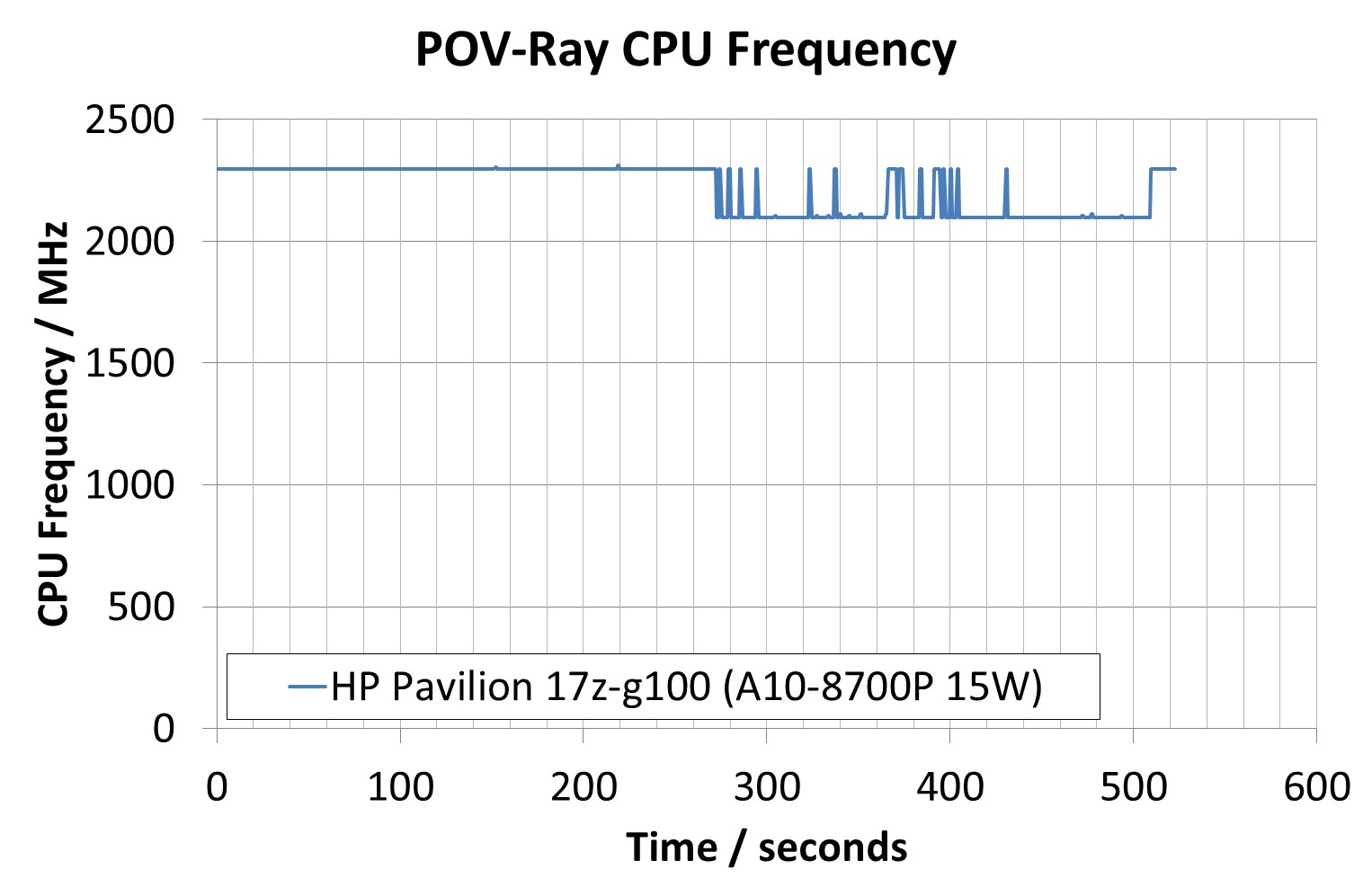
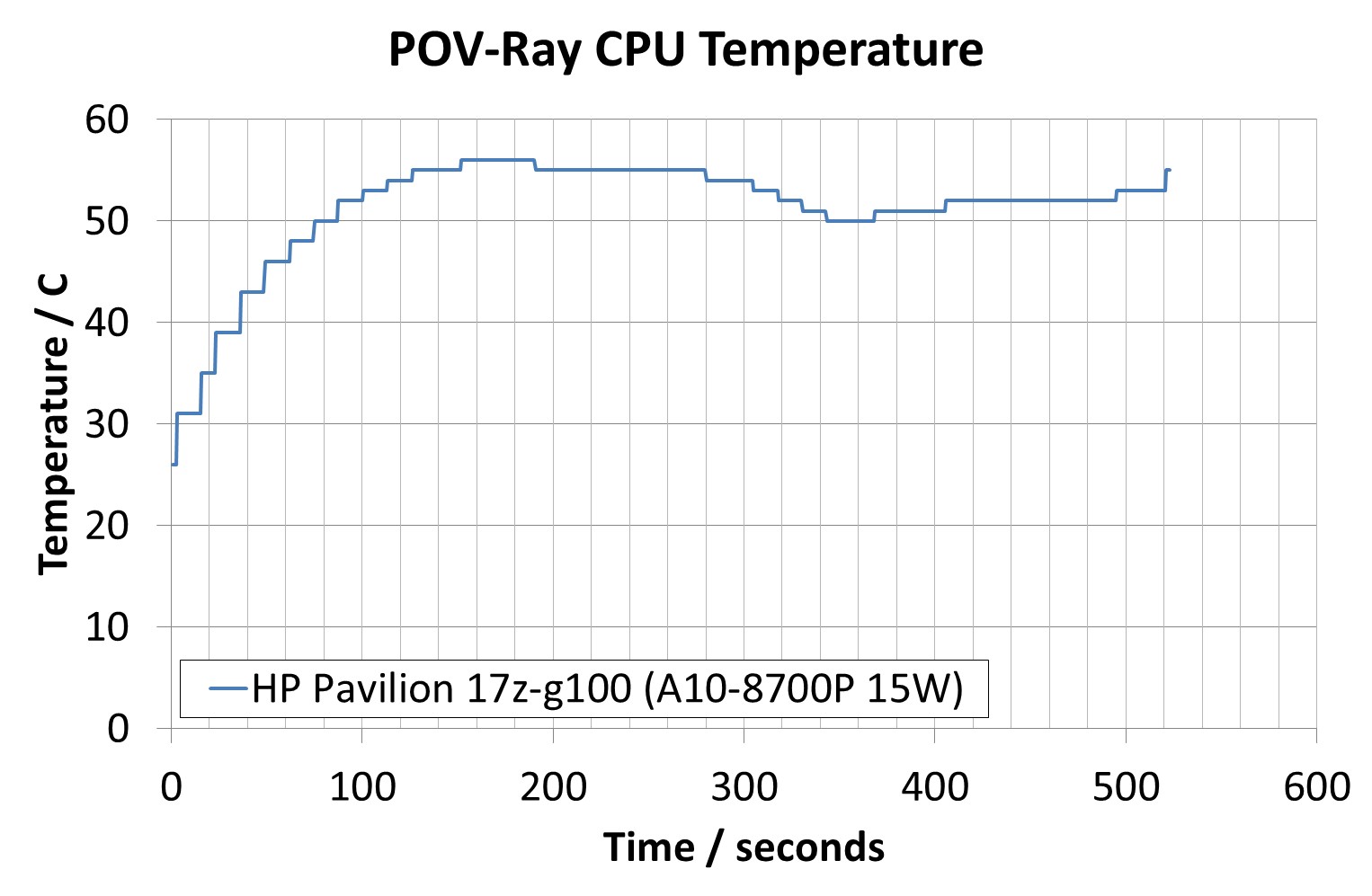


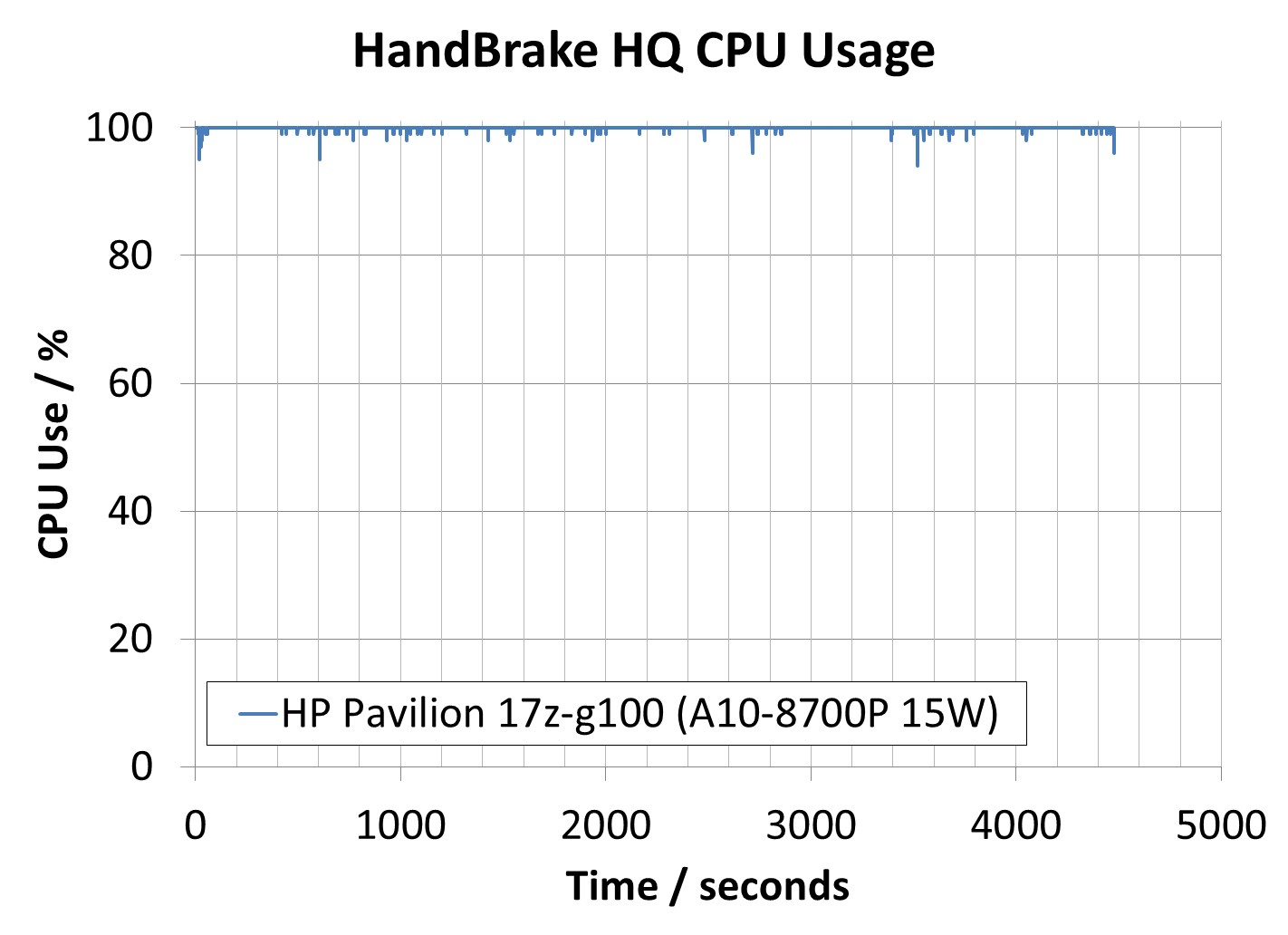

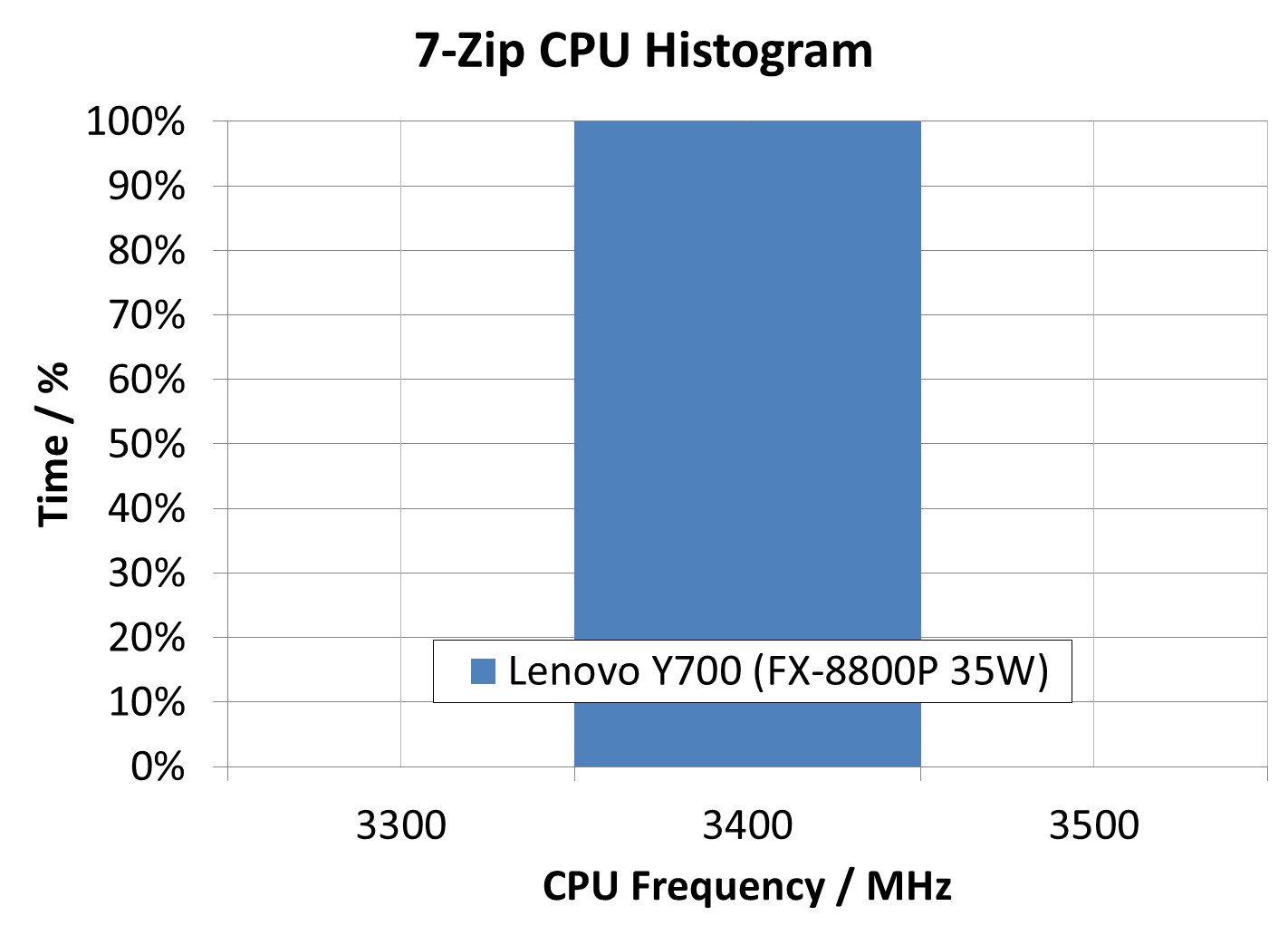









175 Comments
View All Comments
Kylinblue - Friday, February 5, 2016 - link
When I saw the sub-page title "AMD's Industry Problem" I though it is the conclusion, after reading that page I found out I am just at half of the whole article. Well done Ian, well done...ImSpartacus - Friday, February 5, 2016 - link
I know, right? I'm one of those weirdos that reads the pages backwards (mostly), so I was immediately surprised at the list of pages before the conclusion. I honestly haven't finished even half of the article, but it's already evident that some tlc went into it.just4U - Saturday, February 6, 2016 - link
A excellent article Ian.. and actually a surprise I wasn't expecting anything in the pipe like this right now.SviatAI - Friday, February 19, 2016 - link
Unfortunately, this often happens when you work for some ecommerce shop selling various goods, the boss of the shop may not want such kind of articles about the products he or she sells. They want it now and fast, just to fill the site with irrelevant content. The problem is that you want to make something better than a stupid re-write. But who cares? So, I am happy for those guys who write for AnandTech and other similar websites. They can learn something new while doing their job.CajunArson - Friday, February 5, 2016 - link
This article certainly proves one thing: When it comes to price lists on Intel Mobile parts, the numbers you see on ARK have absolutely nothing to do with the actual price that OEMs pay in real life.Observe the supposedly major $200 price premium for Intel chips when you read a price list in a vacuum, but then see that the real-life Intel system [with an honest-to-God *quad core* chip!] is basically selling for the exact same price as a much less capable Chorrizo part.
I personally got a Costco-Special notebook for the wife last year at $500.. it has an I5-5200U, and I assure you that the OEM most certainly didn't sell that notebook at that price after spending $300 on the CPU.
extide - Friday, February 5, 2016 - link
BTW, that's not a quad core. It's dual, with hyperthreading :)CajunArson - Friday, February 5, 2016 - link
When I said quad core I was referring to the Core i5-6300HQ (45W) in the price comparison that Anand posted. It is a 4 physical core part in a notebook that only costs $8 more than a "4 core" Carrizo using AMD's "cores".I am aware that the 5200U is a dual-core hyperthreaded part too. Like I said, the entire price of the notebook including the 5200U was only $500 (it has 8 GB of RAM too).
extide - Tuesday, March 22, 2016 - link
Ah, yes, Intel is FINALLY shipping quad core mobile i5's. Good call :)vladx - Saturday, February 6, 2016 - link
Except you didn't put in consideration that what you bought was called "Special" for a reason and it wasn't the release price of the product that was most likely $200+ more.Braincruser - Friday, February 5, 2016 - link
AMD still has a long way to go before its considered a valid choice. The 4.5W intel beats it in the tasks its gonna be used in. Even in graphics, the supposed strong side of amd's APU.